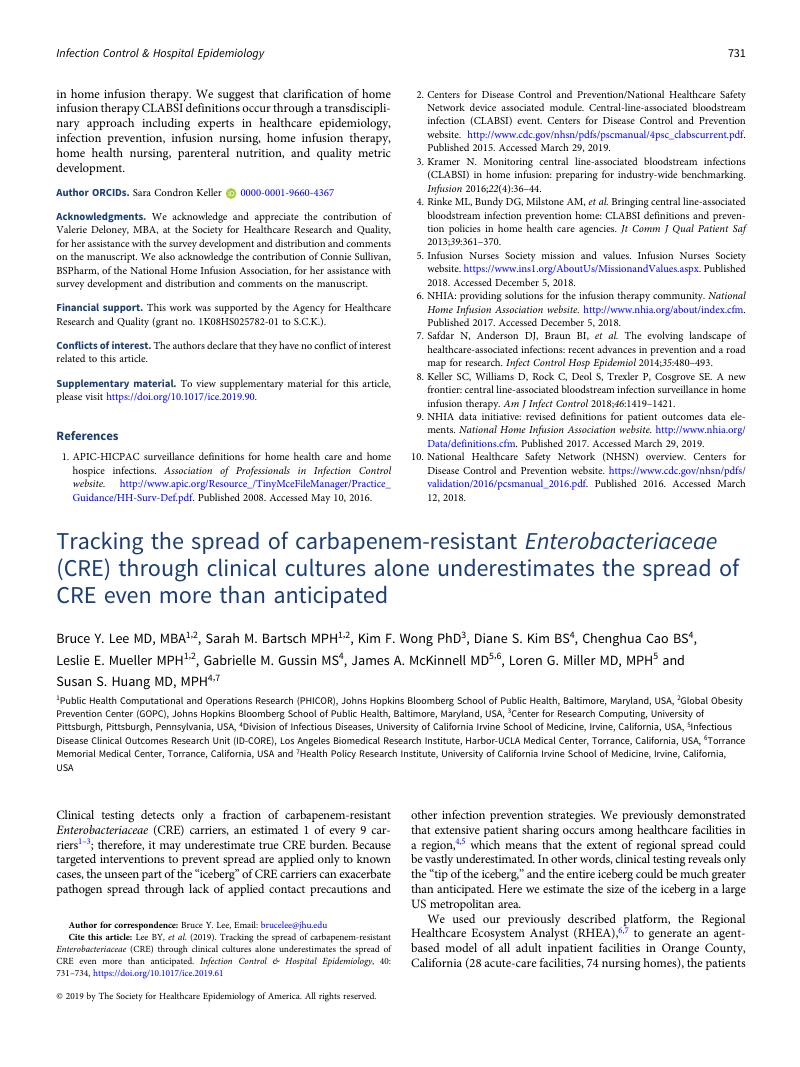Crossref Citations
This article has been cited by the following publications. This list is generated based on data provided by Crossref.
Han, Jennifer H.
Lapp, Zena
Bushman, Frederic
Lautenbach, Ebbing
Goldstein, Ellie J. C.
Mattei, Lisa
Hofstaedter, Casey E.
Kim, Dorothy
Nachamkin, Irving
Garrigan, Charles
Jain, Tanya
Bilker, Warren
Wolford, Hannah M.
Slayton, Rachel B.
Wise, Jacqueleen
Tolomeo, Pam
and
Snitkin, Evan S.
2019.
Whole-Genome Sequencing To Identify Drivers of Carbapenem-Resistant Klebsiella pneumoniae Transmission within and between Regional Long-Term Acute-Care Hospitals.
Antimicrobial Agents and Chemotherapy,
Vol. 63,
Issue. 11,
Humphries, Romney M.
and
Ledeboer, Nathan A.
2019.
CIM City: the Game Continues for a Better Carbapenemase Test.
Journal of Clinical Microbiology,
Vol. 57,
Issue. 7,
Bartsch, Sarah M
Wong, Kim F
Stokes-Cawley, Owen J
McKinnell, James A
Cao, Chenghua
Gussin, Gabrielle M
Mueller, Leslie E
Kim, Diane S
Miller, Loren G
Huang, Susan S
and
Lee, Bruce Y
2020.
Knowing More of the Iceberg: How Detecting a Greater Proportion of Carbapenem-Resistant Enterobacteriaceae Carriers Influences Transmission.
The Journal of Infectious Diseases,
Vol. 221,
Issue. 11,
p.
1782.
Dai, Yunqi
Meng, Tianjiao
Wang, Xiaoli
Tang, Bin
Wang, Feng
Du, Ying
Qiu, Yuzhen
Liu, Jialin
Tan, Ruoming
and
Qu, Hongping
2021.
Validation and Extrapolation of a Multimodal Infection Prevention and Control Intervention on Carbapenem-Resistant Klebsiella pneumoniae in an Epidemic Region: A Historical Control Quasi-Experimental Study.
Frontiers in Medicine,
Vol. 8,
Issue. ,
Mills, John P.
and
Marchaim, Dror
2021.
Multidrug-Resistant Gram-Negative Bacteria.
Infectious Disease Clinics of North America,
Vol. 35,
Issue. 4,
p.
969.
Lee, Bruce Y
Bartsch, Sarah M
Lin, Michael Y
Asti, Lindsey
Welling, Joel
Mueller, Leslie E
Leonard, Jim
Brown, Shawn T
Doshi, Kruti
Kemble, Sarah K
Mitgang, Elizabeth A
Weinstein, Robert A
Trick, William E
and
Hayden, Mary K
2021.
How Long-Term Acute Care Hospitals Can Play an Important Role in Controlling Carbapenem-Resistant Enterobacteriaceae in a Region: A Simulation Modeling Study.
American Journal of Epidemiology,
Vol. 190,
Issue. 3,
p.
448.
Lapp, Zena
Han, Jennifer H.
Wiens, Jenna
Goldstein, Ellie J. C.
Lautenbach, Ebbing
Snitkin, Evan S.
and
Cleary, David W.
2021.
Patient and Microbial Genomic Factors Associated with Carbapenem-Resistant Klebsiella pneumoniae Extraintestinal Colonization and Infection.
mSystems,
Vol. 6,
Issue. 2,
Salamzade, Rauf
Manson, Abigail L.
Walker, Bruce J.
Brennan-Krohn, Thea
Worby, Colin J.
Ma, Peijun
He, Lorrie L.
Shea, Terrance P.
Qu, James
Chapman, Sinéad B.
Howe, Whitney
Young, Sarah K.
Wurster, Jenna I.
Delaney, Mary L.
Kanjilal, Sanjat
Onderdonk, Andrew B.
Bittencourt, Cassiana E.
Gussin, Gabrielle M.
Kim, Diane
Peterson, Ellena M.
Ferraro, Mary Jane
Hooper, David C.
Shenoy, Erica S.
Cuomo, Christina A.
Cosimi, Lisa A.
Huang, Susan S.
Kirby, James E.
Pierce, Virginia M.
Bhattacharyya, Roby P.
and
Earl, Ashlee M.
2022.
Inter-species geographic signatures for tracing horizontal gene transfer and long-term persistence of carbapenem resistance.
Genome Medicine,
Vol. 14,
Issue. 1,
Manoukian, Sarkis
Stewart, Sally
Dancer, Stephanie J.
Mason, Helen
Graves, Nicholas
Robertson, Chris
Leonard, Alistair
Kennedy, Sharon
Kavanagh, Kim
Parcell, Benjamin
and
Reilly, Jacqui
2022.
Probabilistic microsimulation to examine the cost-effectiveness of hospital admission screening strategies for carbapenemase-producing enterobacteriaceae (CPE) in the United Kingdom.
The European Journal of Health Economics,
Vol. 23,
Issue. 7,
p.
1173.
Tadese, Bekana K.
Darkoh, Charles
DeSantis, Stacia M.
Mgbere, Osaro
and
Fujimoto, Kayo
2022.
Clinical epidemiology of carbapenem-resistant Enterobacterales in the Greater Houston region of Texas: a 6-year trend and surveillance analysis.
Journal of Global Antimicrobial Resistance,
Vol. 30,
Issue. ,
p.
222.
Lapp, Zena
Octaria, Rany
O’Malley, Sean M.
Nguyen, Tu Ngoc
Wolford, Hannah
Crawford, Ryan
Moore, Christina
Snippes Vagnone, Paula
Noel, Diane
Duffy, Nadezhda
Pirani, Ali
Thomas, Linda S.
Pattee, Brittany
Pearson, Claire
Bulens, Sandra N.
Hoffman, Sophie
Kainer, Marion
Anacker, Melissa
Meek, James
See, Isaac
Gontjes, Kyle J.
Chan, Allison
Lynfield, Ruth
Maloney, Meghan
Hayden, Mary K.
Snitkin, Evan
Slayton, Rachel B.
and
Diekema, Daniel J.
2023.
Distinct Origins and Transmission Pathways of
bla
KPC
Enterobacterales
across Three U.S. States
.
Journal of Clinical Microbiology,
Pople, Diane
Kypraios, Theodore
Donker, Tjibbe
Stoesser, Nicole
Seale, Anna C.
George, Ryan
Dodgson, Andrew
Freeman, Rachel
Hope, Russell
Walker, Ann Sarah
Hopkins, Susan
and
Robotham, Julie
2023.
Model-based evaluation of admission screening strategies for the detection and control of carbapenemase-producing Enterobacterales in the English hospital setting.
BMC Medicine,
Vol. 21,
Issue. 1,
SOLAK GRASSIE, Semiha
and
ÜNALAN ALTINTOP, Tuğçe
2024.
Trends in Carbapenem Resistance from 2018-2023 in Home Health Care: The Bottom of the Iceberg.
Turkish journal of Geriatrics,
p.
189.



